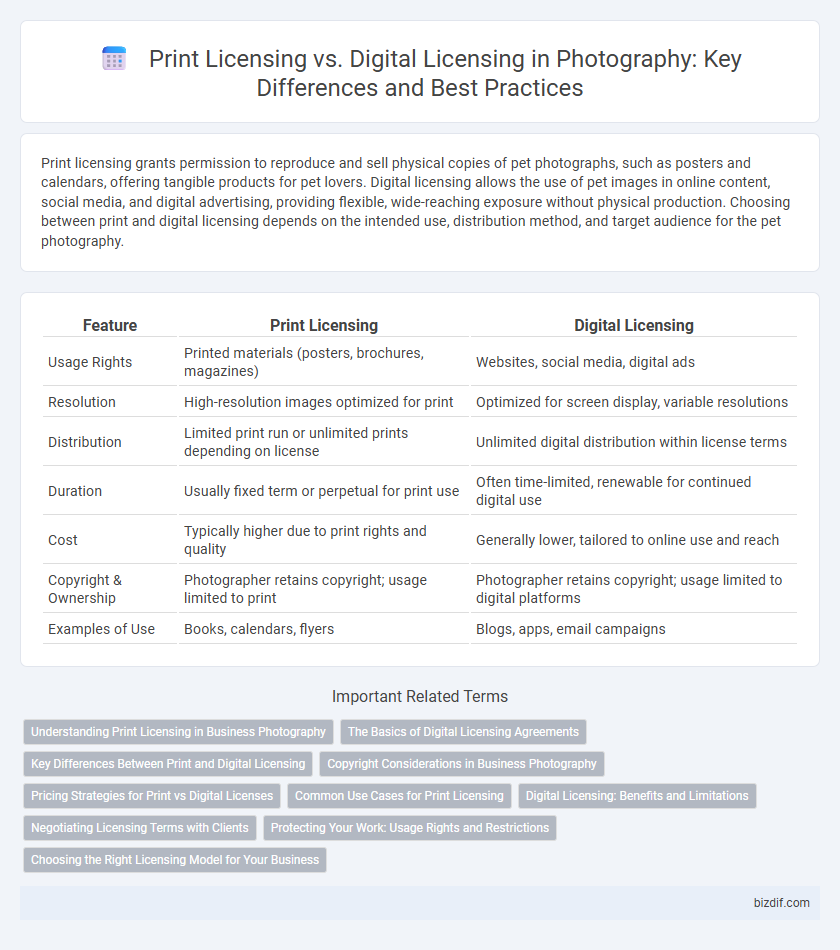Print licensing grants permission to reproduce and sell physical copies of pet photographs, such as posters and calendars, offering tangible products for pet lovers. Digital licensing allows the use of pet images in online content, social media, and digital advertising, providing flexible, wide-reaching exposure without physical production. Choosing between print and digital licensing depends on the intended use, distribution method, and target audience for the pet photography.
Table of Comparison
| Feature | Print Licensing | Digital Licensing |
|---|---|---|
| Usage Rights | Printed materials (posters, brochures, magazines) | Websites, social media, digital ads |
| Resolution | High-resolution images optimized for print | Optimized for screen display, variable resolutions |
| Distribution | Limited print run or unlimited prints depending on license | Unlimited digital distribution within license terms |
| Duration | Usually fixed term or perpetual for print use | Often time-limited, renewable for continued digital use |
| Cost | Typically higher due to print rights and quality | Generally lower, tailored to online use and reach |
| Copyright & Ownership | Photographer retains copyright; usage limited to print | Photographer retains copyright; usage limited to digital platforms |
| Examples of Use | Books, calendars, flyers | Blogs, apps, email campaigns |
Understanding Print Licensing in Business Photography
Print licensing in business photography grants clients the right to reproduce images in physical formats such as brochures, posters, and packaging, with specific limits on size, quantity, and distribution. This type of license ensures control over image use while providing revenue opportunities through fees tied to print runs or geographic regions. Understanding print licensing details is essential for photographers to protect their work and align usage rights with client needs.
The Basics of Digital Licensing Agreements
Digital licensing agreements in photography define terms for using images across online platforms, outlining specific rights such as reproduction, distribution, and modification. These agreements often specify usage duration, geographic location, and exclusivity, providing clear boundaries to protect photographers' intellectual property. Unlike print licensing, digital licenses must address challenges like unlimited copies and ease of unauthorized sharing in the digital environment.
Key Differences Between Print and Digital Licensing
Print licensing grants permission to reproduce images in physical formats such as magazines, posters, or brochures, often with restrictions on quantity and size. Digital licensing covers uses on websites, social media, and digital advertising, emphasizing resolution and display parameters rather than physical dimensions. Pricing structures and usage rights differ significantly, reflecting the distinct distribution and reproduction methods between print and digital media.
Copyright Considerations in Business Photography
Print licensing grants businesses the right to reproduce and distribute physical copies of photographs, with clear limitations on quantity and usage to protect the photographer's copyright. Digital licensing typically covers online display, downloads, or digital marketing use but requires strict terms to prevent unauthorized distribution or modification, crucial for maintaining copyright integrity. Understanding these licensing distinctions ensures businesses comply with copyright law while maximizing the commercial value of photographic assets.
Pricing Strategies for Print vs Digital Licenses
Print licensing pricing strategies typically involve higher fees due to the tangible nature of physical prints and limited edition exclusivity, reflecting factors like print size, quality, and distribution volume. Digital licensing pricing models often depend on usage rights, resolution, and duration, with scalable fees adjusted for web, social media, and commercial applications. Effective pricing balances market demand, image exclusivity, and client budget, optimizing revenue for both print and digital photography licenses.
Common Use Cases for Print Licensing
Print licensing primarily covers the reproduction of images on physical media such as posters, books, magazines, and merchandise, allowing businesses and individuals to legally display or sell printed copies of the photographs. Common use cases include advertising campaigns requiring high-quality prints, editorial publications needing clear usage rights for physical distribution, and product packaging designs incorporating photographic elements. This licensing ensures proper rights management for tangible outputs, distinct from digital licensing that governs online or electronic displays.
Digital Licensing: Benefits and Limitations
Digital licensing offers photographers greater flexibility by enabling instant delivery and broader distribution across online platforms, enhancing visibility and revenue potential. It allows precise control over usage rights through metadata and licensing agreements, minimizing unauthorized use and facilitating easy tracking. However, digital licensing faces challenges such as increased risk of piracy and difficulty in enforcing terms, requiring robust digital rights management tools to protect intellectual property effectively.
Negotiating Licensing Terms with Clients
Negotiating licensing terms with clients requires a clear understanding of the distinctions between print licensing and digital licensing to tailor usage rights appropriately. Print licensing typically involves permissions for physical reproduction in formats such as magazines, brochures, or posters, emphasizing resolution and print run limits. Digital licensing focuses on online display, social media distribution, or digital advertising, often necessitating terms about duration, geographic reach, and exclusivity to protect the photographer's intellectual property and revenue streams.
Protecting Your Work: Usage Rights and Restrictions
Print licensing grants specific permissions for reproducing images in physical formats, controlling distribution and display to prevent unauthorized prints. Digital licensing defines usage rights for online and electronic media, restricting copying, sharing, and modification to safeguard digital assets. Clear licensing agreements outline usage limitations, ensuring photographers retain control over their work while maximizing revenue opportunities.
Choosing the Right Licensing Model for Your Business
Selecting the right licensing model for your photography business hinges on evaluating print licensing and digital licensing based on their usage scope and revenue potential. Print licensing typically grants clients the right to reproduce images in physical media such as magazines, posters, and brochures, often commanding higher fees due to tangible distribution and limited reproduction. Digital licensing offers broader flexibility for online use, social media, and digital advertising, enabling recurring income through extended or multi-platform digital rights, making it essential to align your licensing strategy with client needs and market trends.
Print Licensing vs Digital Licensing Infographic

 bizdif.com
bizdif.com